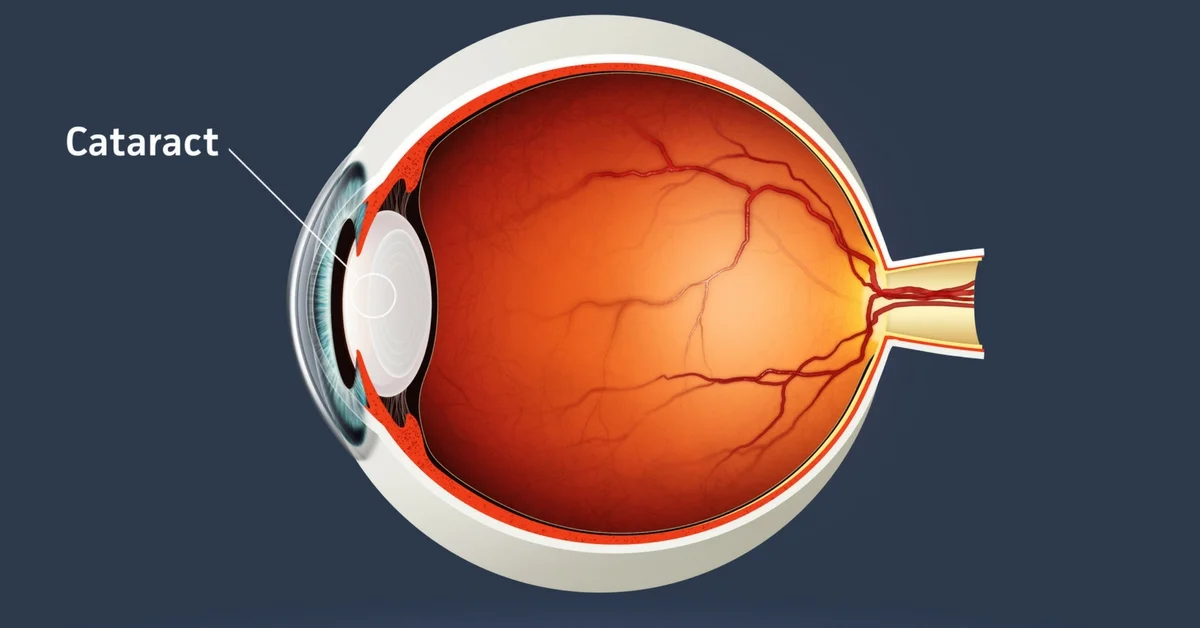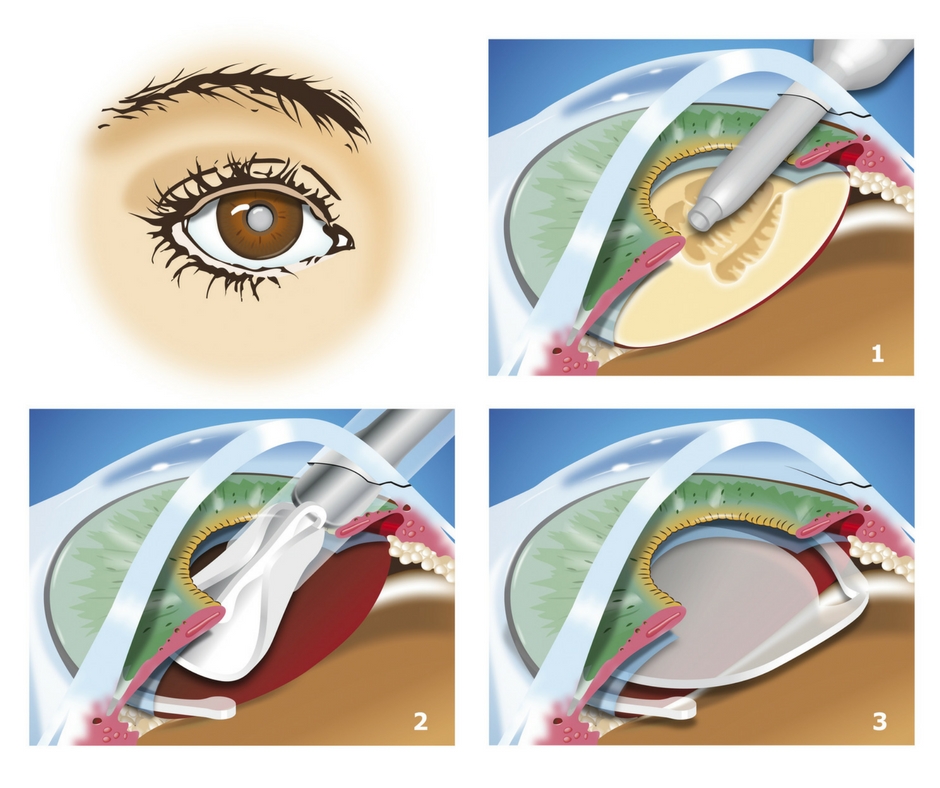Your Guide to Understanding Cataract Surgery in Edmonton
/Cataract surgery is one of the most common eye care procedures that many of us will have to undergo in our lifetime.
This blog post is meant to act as a quick guide to understanding cataract surgery here in Edmonton, as the process may be slightly different in other cities across Canada. It is in no way inclusive of everything, and every patient's situation is unique, but we feel that it's a good starting point.
What is a Cataract?
Cataracts are a natural age-related change THAT WE ALL DEVELOP to some degree during our lifetime. They sound scary, but really cataract development can end up being a positive eye care experience when handled appropriately.
Cataracts are the clouding of the lens structure in the eye which blocks the transmission of light to the retina in the back of your eye, preventing clear, crisp, sharp vision.
Most cataracts develop slowly over many years; this is why people associate them more with their grandparents. But actually, anyone can develop cataracts at any age, even babies. Risk factors that may make cataracts develop more quickly though include trauma, infection, medication use, smoking, excessive sunlight exposure, poor diet, family history, and certain medical conditions like diabetes.
Early stages of Cataracts - The Signs & Symptoms
Most Canadians start showing signs of cataracts in their late 50’s early 60’s. Basically, the lens will start to turn slightly yellowish in colour and will change how light enters the eye.
Cataracts are initially managed by adjusting your eyeglass prescription to maximize visual acuity and to control glare caused by reduced lens clarity. In fact, you may find that you need to change your glasses every year or two to keep up with these vision changes to feel comfortable. We also recommend that patients upgrade to anti-refractive lenses in their eyeglasses if they don't already have them to help reduce additional glare.
Your optometrist may also suggest a few lifestyle adjustments to help slow the progression, which might include smoking cessation, eating more foods rich in anti-oxidants and wearing sunglasses outside.
Because cataracts block light, some patients find it necessary to increase the amount of available light they have for reading. Buying a good reading lamp or desk lamp can help manage most early symptoms. When controlling glare, we recommend that patients try to limit night driving to familiar areas only and reduce non-essential highway driving whenever possible. It's also extremely important to add anti-reflective or non-glare coatings to your eyeglasses.
As cataracts develop, they may start to impair your vision and may make it difficult to properly operate motor vehicles like your car. Over time, cataracts can completely block your vision if they are left untreated. In fact, world wide cataracts are still the leading cause of blindness do to lack of access to appropriate care.
Treatment Options for Cataracts
Currently their is no eye drop or pill available to treat or slow down the progression of cataracts, although their is a significant amount of research in this area.
Eventually, some patients (but not everyone) may require cataract surgery, which involves the removal and replacement of the lens structure in their eye. Currently, surgery is the only known way to treat cataracts. Cataract surgery is not without risk, but it is one of the most successful medical procedures with continual advancements in the procedure each year.
How Much Does Cataract Surgery Cost in Edmonton?
Because cataracts are a medical condition, there is currently no charge to have this procedure performed in Alberta. If you have a valid Alberta Health Care card you will be covered for the complete procedure and the visit with the ophthalmologist. All or a portion of your pre-surgical and post-surgical visits with your optometrist will also be covered.
The only cost you will incur for cataract surgery in Edmonton is the cost of the eye drops prescribed by the surgeon, which are required for post-surgical care. These medications are usually prescribed for between 3-6 weeks. If you have a drug plan, all or a portion of these costs may be covered.
In Alberta, there is NO COST for cataract surgery if you have a valid Alberta Health Care card. Our government provides top-of-the-line monofocal lens implants to all patients requiring this procedure.
Based on your optometrist or surgeon’s recommendation, some patients may elect to upgrade the intraocular lens (IOL) implant used during the operation.
These enhanced lens implants DO NOT improve cataract surgery outcomes or eliminate risk, but instead, focus on reducing the need for eyeglasses post-surgically. Even with enhanced lens implant options, most patients still require eyeglasses to maximize their visual acuity, be it for driving or reading.
It’s a common misconception that
people no longer need glasses after
cataract surgery, even with premium IOL lens options.
Because your surgeon may be able to adjust your final prescription, it’s important to think through how you would like to see the world. Just because a surgeon can make you see in the distance without eyeglasses, doesn’t mean that’s always the best option.
To highlight this point, let’s look at a few typical patient examples.
Cataract Case #1
Meet Anna. Anna is 85 years of age and is an avid sewer and reader. She spends most of her time in the house and has seldom worn eyeglasses, except to drive or watch TV.
Anna - Cataract Case #1
She finds that her vision is ok for most activities up close but recently noticed that it’s harder to read the fine print in the newspaper. After seeing us for an eye exam, she was diagnosed with cataracts and was referred to a local Edmonton cataract specialist for a surgical consultation. Initially, she thought it would be fun not to need eyeglasses to drive, but when she learned she would need glasses to read, sew, put makeup on and cook in the kitchen, she quickly lost excitement over the idea.
In the end, we recommended a standard monofocal IOL lens implant designed to keep her prescription the same as it had been for years, slightly nearsighted. In the end, she couldn’t have been more excited or happy with the visual outcome. Anna can read again without eyeglasses and still only wears her glasses to drive or watch TV.
Cataract Case #2
Peter is a 61-year-old ex-construction worker who’s spent most of his life working and playing outdoors. He’s young when it comes to cataracts, but he told us that he rarely wore sunglasses and smoked about a pack of cigarettes per day before retirement.
Peter - Cataract Case #2
He had perfect vision in the distance until about 10 years ago when he started needing eyeglasses to drive. Initially, he only needed glasses to read, which was fine, but the loss of his distance vision had him less than impressed. He went for a laser eye surgery consultation, hoping that LASIK might improve his vision, but was told he wasn’t a candidate because of cataracts and was referred to our office.
We examined and diagnosed Peter with cataracts in both eyes, and he was holding on to the legal driving limit with his current eyeglasses. A new prescription made little difference, and we referred him to see a cataract surgeon in Edmonton before things got worse.
In his case, we recommended a monofocal IOL lens implant designed to return his distance vision prescription to zero without causing night glare experienced by some of the enhancement multifocal lens implants. He understood that he would still need reading glasses afterwards but was excited not to need eyeglasses all the time, especially for driving.
Cataract Case #3
Jennifer is 55 years old and has had Type-1 diabetes. She’s had eyeglasses all of her life, and like many Edmontonians had dreamt about not needing them. She's nearsighted with lots of astigmatism in both eyes and doesn't like contact lenses.
Jennifer - Cataract Case #3
Unfortunately, Jennifer got sick about a year ago, which caused her diabetes to go out of control resulting in significant fluctuations in her blood sugar levels. During this time, she noticed changes in her vision, but things usually stabilized when her blood sugars returned to normal. She showed up for her annual diabetic eye exam, looking for new eyeglasses to sharpen her vision again because she was having problems driving.
However, her eye exam revealed a particular cataract called a posterior subcapsular cataract or PSC affecting her vision. (PSC cataracts are more common in younger patients and those with diabetes (Type-1 or Type-2), who experience fluctuating blood sugar levels.) In the end, we agreed that she required cataract surgery, and we booked a consultation.
Jennifer liked being on the cutting edge of things and was interested in considering enhanced lens options if she was a candidate. We reviewed the pros and cons of all the currently available lenses we could choose from, including Monofocal Lens Implant (distance or near), Monofocal Lens Implant plus Astigmatism Correction, Multifocal Lens Implant, Multifocal Lens Implant plus Astigmatism Correction. In the end, Jennifer ended up choosing the visual predictability of an enhanced monofocal lens implant with astigmatism correction. This meant she would have excellent distance vision and would only require eyeglasses for reading and computer work.
Let's break down her lens implant options so you can see the thought process we went through.
Monofocal Lens Implants - (One distance only, does not correct astigmatism) - This option is fully covered under Alberta Health Care. However, she would still need eyeglasses to correct both her distance and near vision because these lenses don't correct astigmatism. Patients without astigmatism could choose this lens to either correct their distance vision (Like Peter in Cataract Case#2) or be left slightly nearsighted to read (Like Anna in Cataract Case#1).
Monofocal Lens Implant with Astigmatism Correction - (One distance only plus astigmatism correction) This option is partially covered under Alberta Health Care; there is a co-pay for the more enhanced lens implant. The benefit here is that the lens implant would correct both her nearsightedness and astigmatism. She would no longer require eyeglasses for distance, but she would still need glasses for working on the computer and reading.
Multifocal Lens Implants - (Distance and Near) or Multifocal Lens Implant with Astigmatism Correction (Distance and Near plus Astigmatism). These surgeries are partially covered under Alberta Health Care; there is a co-pay for the more enhanced lens implants. We decided against using a multifocal lens implant because many patients report reduced contrast sensitivity (fine detail vision) and increased glare from around lights. Two things patients with cataracts already suffer from. Unfortunately, eyeglasses cannot correct either of these side effects post-surgically, and an accurate glasses prescription is challenging to get. As such, multifocal lens implants are still rarely used by most cataract surgeons in Edmonton. As technology advances, however, this may be something we see more regularly performed in the future.
AcrySof IQ IOL family of lenses by Alcon -Image Via Alcon.ca
Where will my cataract surgery be performed?
Most cataract surgery procedures in Edmonton will occur at the Royal Alexandra Hospital, the hub for ophthalmology in this city. But there are also some external Alberta Health Care approved surgical sites located around and within the Edmonton area.
Your eye health and personal health will be factored in determining the best location for your cataract surgery. The surgeon performing the procedure will help you choose an appropriate location for your situation.
The Bottom Line
The bottom line is that cataracts are normal event in life that can also be a positive experience. Should you be diagnosed with cataracts, it is important to talk with your optometrist about the options you have available so that your wishes can be passed on to the ophthalmologist. In the end, only you and the cataract surgeon performing the procedure can decide on the best lens implant option based on your situation and your unique set of risks and complications.
The diagnosis and treatment process around cataracts can seem overwhelming, but if you have questions, please ask. Or see if we've answered in our FAQ section below.
Cataracts | FAQ
Costs
+ How much does cataract surgery cost in Edmonton?
If you have a valid Alberta Health Care card, there is no cost to have cataract surgery in Edmonton.
+ I heard that some surgeons are charging patients for cataract surgery.
As noted above, cataract surgery is covered by Alberta Health Care. There is no cost for the procedure.
Cataract surgeons are charging patients for enhanced elective lens implants which are not covered under Alberta Health Care. These enhanced lens implants do not make the surgery safer or better than the essential government covered procedure but instead focus on trying to reduce or potentially eliminate the need for eyeglasses post surgically.
Using an enhanced lens implant does not guarantee you that you will not require eyeglasses post-surgically. Most patients still have a slight refractive error and could benefit from eyeglasses for driving and reading.
+ Why do cataract surgeons ask for a referral from an optometrist or another ophthalmologist?
The wait times to see most cataract surgeons is relatively long and it can be 6-20 weeks or longer to get an initial consultation. As such, surgeons want to know that the reason for your vision loss is secondary to cataracts and not another underlying eye health condition.
Also, most cataract symptoms can be alleviated with an adjustment in your eyeglass prescription which can delay the need for surgery while maintaining good functional vision for driving and reading.
The Procedure
+ Does cataract surgery hurt?
No. Cataract surgery is a painless operation. The surgeon will either apply a topical eye drop or administer an anaesthetic injection to numb the eye area. Most patients report a scratchy sensation around the incision area for 3-4 hours after the operation while the incision site heals.
+ Will my cataracts come back?
No. Once removed a cataract cannot reform. Occasionally patients might develop a 'secondary cataract', which is a film that forms on the back side of the lens implant. This film can be removed by your cataract surgeon using an in-office laser procedure and is considered a common benign complication after modern cataract surgery.
Book Your Next Eye Exam at Stonewire Optometry
Kingsway Mall | Edmonton | Alberta
Contact Us
Please Note: All case examples are fictitious and do not represent real Stonewire Optometry patients. These case examples are used to highlight common eye care problems and potential solutions. Every patient’s situation is unique and it is important to discuss your case with your eye doctor to find your best option. These posts are not intended to offer treatment advice, but to improve patient knowledge and facility better doctor-patient communication.
Check out some of our other popular eye care articles:















